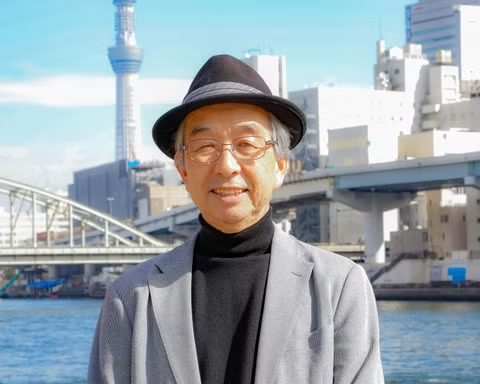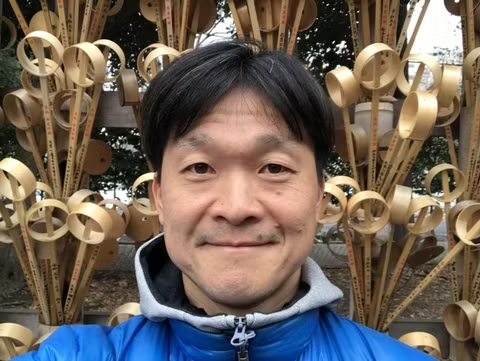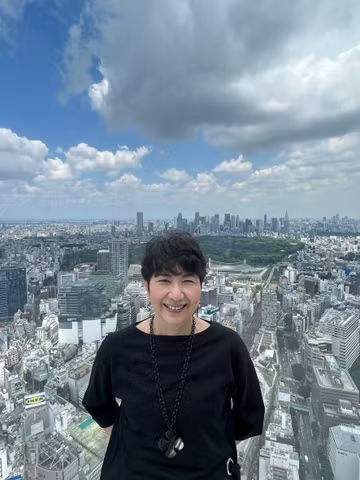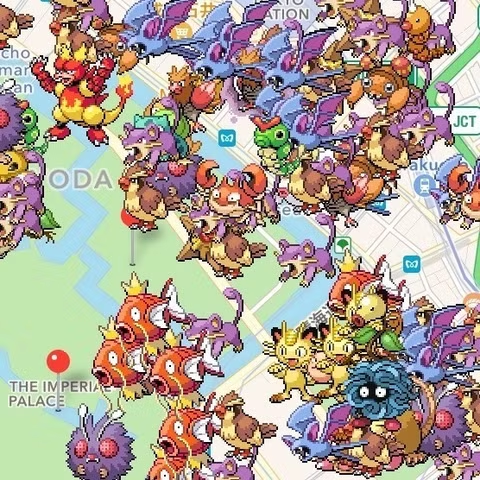Meiji Shrine, or Meiji Jingu in Japanese, is one of the most famous sightseeing spots in Tokyo. It is a large Shinto shrine in the middle of the city. At New Years, more than 3 million people visit this shrine to offer their first prayers of the year. It’s a tradition called “hatsumode”.
The Meiji Shrine is the most popular shrine to go for “hatsumode” so you have to line up for hours to get to the main shrine building itself. When you visit this shrine on a weekend, sometimes if you’re lucky, you’ll be able to see a Shinto style wedding. Or in mid-November, you may be able to see little children dressed of ages 3, 5, and 7, in kimonos celebrating “shichigosan” (literally “seven-five-three” in Japanese), a tradition to pray for the healthy growth of children.
Location and Access to Meiji Shrine
You can get to Meiji Jingu Shrine easily from Harajuku station. There is a huge “Torii” gate at the entrance to this wooded area, and as you walk the gravel path to the shrine’s main building, the tall trees surround you on both sides. It’s as if the forest swallows you up whole and the modern city disappears behind you. The shrine grounds are located right in the middle of a lively area full of young people, but once you enter the grounds, you tend to forget where you are because it feels so serene and peaceful.
It would be a good idea to visit Meiji Shrine along with touring the Harajuku, Omotesando, and Shibuya areas because of their vicinity to each other. If you don’t know exactly what to see or where to go, take a tour of Tokyo with a local guide. You’ll be able to find many local guides who provide all types of tours at GoWithGuide. You’ll be able to learn about Japanese history and culture as well as see the modern side of Tokyo too. So take a look and see what interests you.
Address: 1-1 Yoyogi Kamizonocho, Shibuya-ku, Tokyo
Entrance Fee: free of charge
Access: a 1-minute walk from JR Harajuku Station or a 2-minute walk from Meiji Jingu-Mae Station on the Fukutoshin Subway Line
Hours: sunrise to sundown
Travel Tip: Because of the gravel paths, it’s very difficult to access the shrine by wheelchair. If you hire a private car or a wheelchair accessible taxi, the car can take you up to the parking lot next to the main shrine building. From there, the path is not gravel, so it makes things much easier.
History
This Shinto shrine is dedicated to the deified spirits of the Meiji Emperor and Empress. After he passed away in 1912, the government decided to commemorate his role in the Meiji Restoration. He was the first emperor of modern Japan when Japan opened up its doors to the western world.
The location of the shrine was once an iris garden that the imperial couple liked to visit. The original shrine was completed in 1921 and was built using mainly Japanese cypress wood and copper. It was unfortunately destroyed during the bombings of World War II and was rebuilt again in 1958 through a public fundraising effort. The 70 hectare forest is made up of 120,000 trees of 365 different species, which were donated from all over Japan.
The grounds of Meiji Shrine are adjacent to Yoyogi Park, another one of Tokyo’s sightseeing spots. In comparison to the shrine grounds, Yoyogi Park is full of large open lawns where people can relax and enjoy picnics or exercise. It was the location of the Olympic Village for the 1964 Tokyo Olympics. And the National Olympic Stadium also stands on the outer precincts of Meiji Shrine. It was there for the 1964 Olympics, and the newly rebuilt stadium has been built on the same site for the 2020 Tokyo Olympics.
![]()
The Shinto Religion
Shintoism is considered the indigenous religion of Japan. In this religion, they believe that all things, even inanimate objects, have a spirit. All the spirits, whether the object is big or small, are worshipped equally and are called “kami” or gods. Shinto literally means the “path (study) of kami” in Japanese. There is no doctrine nor a founder to the religion, and it originates from collective native beliefs and/or mythology. Nature and the gods are the one and the same, and the practices that were thought to connect humans with the gods have developed into worship rituals over time.
When you pray at a Shinto shrine, stand before the altar and bow twice. Then clap your hands twice. Put your hands together in front of you, close your eyes, and offer a prayer. After you’re done praying, bow again once before leaving the altar. If you’re a little anxious about getting it right, just copy the person in front of you. Even if you don’t get it right, just be respectful and nobody will mind.
Events
There are all types of Shinto ceremonies being held at Meiji Shrine, all year long. There are some only for the followers of the Shinto faith, and then there are others where everyone is welcome. The largest event of the year is the “Aki-no-Taisei” (Autumn Grand Festival). This festival is always held from the 1st to the 3rd of November. It is especially important to Meiji Shrine because the birthday of the enshrined deity, the Meiji Emperor, is on November 3rd. November 3rd is a national holiday in Japan and is called “Bunka-no-hi” or Culture Day. There are performances of all kinds of Japanese cultural arts during the three days of the festival, but the last day is the most elaborately celebrated.
You’ll be able to see displays of “Ikebana”, the art of traditional Japanese flower arrangement. There will also be performances of traditional Japanese music and dance. Of these performances, “Noh” and “Kyogen” are considered sacred theatrical performances, so you are not allowed to photograph them. Exhibitions of all types of Japanese martial arts will also be shown. The martial arts using just the human body like “Judo” or “Karate” are well known, but you’ll also be able to see performances using mock swords and spears. Traditional Japanese archery is also something you can’t see every day.
However, the “Yabusame” performance is the most popular above all. “Yabusame” is the art of shooting arrows at stationary targets from atop a galloping horse. As you can imagine, this is an amazing feat. If you want to see it up close, you’ll need to go early and wait along the horse track, as a lot of people will be coming to see the performance. All of these exhibitions will be held in traditional costume, so that is another feature you can enjoy.
Sightseeing spots near Meiji Jingu Shrine
![]()
Harajuku
As mentioned before, Meiji Shrine is right next to Harajuku station. Harajuku is a harsh contrast to the tranquil atmosphere of the shrine grounds. It is always busy with people because it is one of the places in Tokyo where young people gather to shop and just have fun. It’s the birthplace of the “kawaii” or cute culture, and you’ll be able to find all kinds of cute clothes, cute toys, cute accessories, and even cute food. If you have children or teenagers in your family, it may be a place they will enjoy. Takeshita street is the Main Street to see, but beware not to get lost in the crowd.
Omotesando
Contrary to the cheaper stores for the younger generation of Harajuku, the neighboring area of Omotesando is more geared toward affluent adults with high-end boutiques. This sophisticated street starting from the edge of Harajuku station is called the “Champs Elysees” of Japan. If you enjoy shopping or even just window shopping, a stroll down this street will be enjoyable. The long street is lined with trees, so it’s a welcome break from the hot sunlight of summer, and it’s illuminated at night in winter time, making it a romantic place to take a walk.
Shibuya
Shibuya is one station over from Harajuku. It’s also a place that the younger generation gathers. Along with Harajuku, this area is where popular brands have their flagship stores or foreign brands set up their very first shop in Japan. It’s a place from where trends start. As a sightseeing spot, the famous Shibuya intersection is something to see. It’s an unusual crossing where people are able to cross from all four street corners at the same time. With the hundreds of people waiting to cross the street, it would seem that this system would in sure chaos, but watch how the local Japanese do it. Amazingly, they’re able to walk across with ease, without bumping into anybody.
Tourists like to take a video or a photo as they cross the intersection, but be sure to be aware of your surroundings as you’re doing that because the pedestrian light doesn’t stay green for long. Another new sightseeing spot is the observatory at the Shibuya Scramble Square building. Sunset or nighttime is recommended for the best view.
Meiji Shrine is conveniently located in the middle of the city, so it’s an easy place to insert into your sightseeing itinerary. If you’re not sure about how or where else to see in Tokyo, try booking a tour of Tokyo. There are lots of places to see in the city other than the areas adjacent to Harajuku, and if you’re visiting a shrine, why not visit a temple as well? You can learn about their similarities as well as their differences, like the proper way to offer a prayer. It’s a very easy way to experience Japanese culture and tradition.









